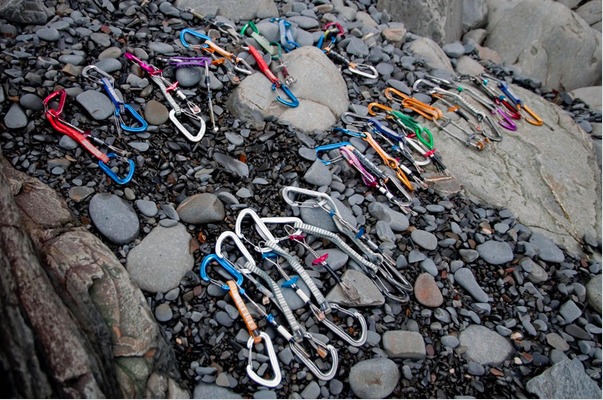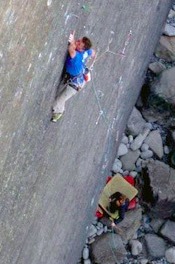Ball-Nuts?
|
|
Just saw a photo on weigh my rack (papa bless) and there was some active pro that looked pretty wack. Ball-Nuts? What are they, how are they, how are you? Hydrated I hope. Godspeed my dudes. |
|
|
https://www.youtube.com/watch?v=68CLGUZ4E8s
I have the 3 smallest sizes for when clean aid gets extra tricky. they are almost 100% worthless if there is any flare to the placement at all if you fall on/bounce test them you better have a hammer and a nut tool to get them back out (punch the slide back in the opposite of the direction it was placed/weighted) very specialized. i personally wont carry mine or bring them on anything except a wall that might require weird C3+ or other shenanigans hot tip: the blue ballnut (smallest one) has a 7kn rating and is roughly the size of a standard cam hook....(or a #1 arrow if you are into that kind of thing) |
|
|
|
|
|
Agreed with Parker. I only use the 3 smallest and then only for aid climbing. I supposed if I were climbing a route that I knew was run-out except for a really thin seam then I would bring the ball nuts so I'd have at least some protection, but that doesn't happen very often. |
|
|
Joe is one of the masters, I've requoted his piece over and over again. |
|
|
Conversely, I only use them for free climbing and have fallen on them multiple times with the #3 holding six 25-30' falls in a row and still came right without the slightest problem, but there is a learning curve. Rich has some great advice here: rgold wrote: |
|
|
Love them! As already stated, most useful are the smaller sizes. Certain spots they are all that will do. |
|
|
I climb with the #3 and #4 regularly and take doubles of #2 and #3 as well on FAs. |
|
|
I’ve taken a 10’ fall on shit sandstone on the largest and it held like a champ. Even if you’re not 100% on trusting those physiological pieces can be very important |
|
|
Will we know go into the tangent of mental pro? |
|
|
Comments on marginal (mental) pro from another thread on small cams and applicable to ballnuts: Healyje wrote: Small, marginal pro - it's a thing, but it's shouldn't be a beginner or intermediate leader thing. The deal with leading over marginal gear is that it's a matter of solid skills, experience, and judgment. Your ability to see and assess such placements needs to be above average, your placement skills need to be excellent, and you need to have a decent track record of calling the odds on a marginal piece[s] holding/blowing. Bottom line? If it's just a complete wild-ass guess you should bail. |
|
|
Ball nut city! Walk of Life, E9 6C, Dyers Lookout, Devon. See https://www.ukclimbing.com/news/2010/11/charlie_woodburn_repeats_the_walk_of_life-59099 A shot of the climb: First-ascent video: |
|
|
Ball nuts are probably the most underrated piece of climbing protection out there. They're really your only option to protect very thin seams, and therefore the ability to place them is an essential skill to master for any traddie (else run it out!). It's a shame that people's aversion to them oft results in climbs or sections getting the gun. |
|
|
Good find on the video Rich. Interesting they'd still bother with half ropes on a route like that - seems entirely unnecessary. |
|
|
I dunno Joe, the route doesn't exactly follow a single crack; even if the climbing line is somewhat direct, the protection wanders from side to side and half ropes mean less fiddling with long runners, which also increase fall length on sketchy pro. Here is a small frame from a much larger shot that, while low on quality, still gives an example of how the pro is distributed around the general climbing path. Plus, when doubling up gear, one of the easiest ways to distribute the load is just to clip one strand to each piece, and with runout climbing under pressure, getting the best set-up with the least mucking around counts for a lot. And when the gear is sketchy, the straighter rope paths obtainable with half ropes means less system friction and so more of each rope available for energy absorbtion, resulting in lower loads to those dicey placements (I think this is why people mention the "soft catch" provided by half ropes in spite of the fact that, when tested, their maximum impact loads are no different from single ropes). Finally, you can place crappy gear overhead and fall on it (while still underneath) and not pay a big slack penalty if the overhead piece blows. |
|
|
Yeah, still not sure it's worth the hassle in this case other than not having to expend the energy to extend the pro, but then on marginal pro like that, I typically like having extended draws. They're clearly the pros from Dover, however... |
|
|
There is also the fact that the Brits are very used to half-rope technique, don't experience it as any kind of "hassle," and might select it out of comfort as much as necessity. |
|
|
I’ve used ballnuts a few times, and have fallen on the second-smallest (never the smallest). I’ve never had a problem cleaning them, but they can be tricky to place. |
|
|
Ball nuts are one of the best investments I've made into my now double rack |

 Continue with onX Maps
Continue with onX Maps Sign in with Facebook
Sign in with Facebook
























